On an overpass in North Portland overlooking Interstate 5, Kathryn Nock and Jordan Stokes are taking stock of the neighborhood, including nearby Harriet Tubman Middle School.
What do they observe? What does the area smell like? What does it sound like?
“It’s kind of hard to hear, huh?” Nock says over the sounds of cars and trucks rumbling under their feet. It smells like exhaust.
Nock scribbles notes on a clipboard, observations of both the natural and human environment around them.
Nearby, two other pairs of college students discuss their surroundings.
They’re all future teachers, graduate students in Lewis & Clark College’s Masters of Teaching program, exploring North Portland with their professors Liza Finkel and Cari Zall.
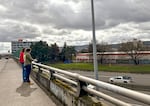
Aidan Hanley, left, and Cooper Bulens, right, take notes of their observations on an overpass over Interstate 5 during a place-based lesson March 13, 2024. Hanley and Bulens are teaching candidates in the Lewis & Clark graduate school.
Elizabeth Miller / OPB
This is their classroom today, examining the human and nonhuman impacts of the upcoming I-5 expansion project on Tubman and the North Portland neighborhood surrounding it. The goal is to give these graduate students a real-life way to incorporate what’s called “place-based education” into their teaching by participating in a lesson themselves.
Stokes, a future social studies teacher, says place-based lessons show students that what they’re learning is relevant to their environment and their community.
“When you have local, real examples of how these different things interplay and affect people’s lives, I think that’s really powerful,” Stokes said. “I think that connects and makes them [students] want to learn more.”
Place-based learning connects what students learn in the classroom or in a textbook with real-world events. For teachers, leaving their classroom provides opportunities and challenges, from creating memorable and relevant ways for students to become more involved in their communities to navigating the logistics of planning a field trip. The Lewis & Clark trip, led by Finkel and Zall, gives teaching candidates at the school a chance to learn about creating a place-based lesson before they get into their own classroom.
Finkel directs the secondary Master of Arts teaching program at Lewis & Clark and advises science and math teaching candidates. Zall is a Lewis & Clark faculty member who advises social studies teaching candidates.
Finkel and Zall agree — you can’t teach science and social studies just by showing a sample under a microscope or reading from a history textbook. Getting out of the classroom can be a way to better engage students.
Finkel’s group of science teachers has been talking all year about how to incorporate local issues into teaching science. Her class has discussed the Klamath River dam removal — how they’d teach it, what’s the science in the story, and what the social dimension of the story is.
Their field trip to North Portland provided an opportunity to get out and explore those answers through another topic: the I-5 expansion project’s effect on a community.
“[It] seemed like a really really good example to get them out and be in a place where they could not just read about a problem but actually physically experience what it’s like to be in this place where people’s lives and wellbeing, and the lives of the plants and everything around it are being affected by decisions that people are making around changing the environment,” Finkel said.
Finding social studies and science in the widening of a freeway
Standing across the street from Harriet Tubman Middle School, Madi Pastores points out a freeway sign she can see in the distance.
“I’m from Oregon but honestly, I’m not very knowledgeable of the Portland area, and so actually seeing what the space looks like and feels like is so different from what I can imagine it to be when I’m reading it,” she said.
Pastores is studying to be a social studies teacher. As she walks down North Flint Avenue with future science teacher Max Marckel, the sound of the I-5 freeway beneath them becomes even louder.
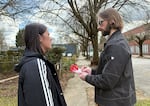
Madi Pastores, left, and Max Marckel, right, are graduate students at Lewis & Clark. The future teachers are exploring how human development impacts a community as part of a place-based lesson in a North Portland neighborhood.
Elizabeth Miller / OPB
Tubman reopened in 2018 after Portland Public Schools spent millions of dollars in air quality system improvements to the school. Discussion of a possible I-5 expansion impacting the school has swirled for almost as long as the school has been open, prompting years of student-led protests and a back-and-forth between PPS and state officials.
Now in 2024, the I-5 Rose Quarter Improvement Project is moving forward and Tubman will have to move. District leaders haven’t announced where the school’s 300 students will go.
The I-5 project is part of a long legacy of decisions that have harmed Black residents in Portland living in the Albina neighborhood. Efforts are also underway to reclaim and redevelop the area by covering I-5 and purchasing the nearby PPS headquarters building.
To prepare for the Lewis & Clark field trip, Finkel and Zall sent the graduate students some reading on the neighborhood, the freeway expansion, and how nature is impacted by development.
Those readings and an essential question lead the conversation.
“Our essential question is, how can we teach about how human development impacts a community or a neighborhood — both the human part of the neighborhood and the more than human part of the neighborhood?” Zall asked the students.
The graduate students — three in the social studies teaching program and three in the science teaching program — shared some initial ideas for how they might approach a place-based lesson in the area.
“What value do we place in infrastructure development? What value do we place in education and the students that live in and are part of a community compared to more space for cars?”
“What primary sources [do] we have to actually see what changes have happened over the course of development?”
“Who benefits, and what is the cost, and who is bearing the cost of the widening?”
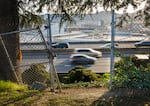
FILE: The I-5 freeway is seen through the fencing at the back of Harriet Tubman Middle School in North Portland, April 9, 2021.
Kristyna Wentz-Graff / OPB
“The idea is to have them really apply this experience that they’ve had today with some readings beforehand, the observations, the questions we’ve asked to actually create something they could at least begin to think about using with their students,” Finkel said.
After spending time observing the environment, the future teachers got together and talked about what their lessons might look like. They drafted lesson plans and talked about all of the different topics and ideas that could connect to a place-based lesson in North Portland.
Development, modernization, capitalism, the changes in wildlife all came up as ideas. The graduate students also noted how other sources like air quality data or old photos could add to a lesson about the neighborhood.
All of the students are currently student-teaching in high schools across the Portland metro area. Some are miles away from North Portland and suspect it might be difficult for their students to understand how complicated and problematic a freeway expansion could be.
“Most of them won’t have the context of that continual displacement, centuries of displacement in the community,” said Jordan Stokes, who wants to teach social studies.
These future teachers are also thinking about and framing their lessons with a social justice lens. It’s part of their Lewis & Clark teacher training.
“Even when it gets down to the nitty gritty of science and social studies content, they’re still up there thinking, ‘what are the social justice questions, the equity issues, the access issues, what are those?’” Finkel said.
Building informed citizens through learning locally
A 2023 review of research on place-based education found expected outcomes of this practice include environmental awareness, positive attitude to a specific place or environment, critical thinking skills, and understanding of social justice principles.
Nock wants her future students to be able to critique the world around them.
“My goal for students is to make them start thinking about things in a more complicated way, even if it’s uncomfortable,” Nock said.
Part of that means teaching how connected science is to everything.
“If you study biology or life science, it’s not only happening in Antarctica or in an old growth forest, biology is happening right here on the sidewalk next to this cement, or right here where these invasive species are crawling in,” she said.
She said it’s also about teaching students how science is affected by power, control and people’s decisions.
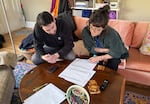
Lewis & Clark graduate students Jordan Stokes, left, and Kathryn Nock, right, give feedback on classmates’ lesson plans. Stokes and Nock were part of a group of future social studies and science teachers wrapping up a lesson on place-based learning.
Elizabeth Miller / OPB
Place-based learning is not a new concept, especially in Oregon. The statewide Outdoor School program is one example, a long-running program that gets middle school students out of the classroom and into forests, watersheds, and other natural areas to learn about science. Portland’s Cottonwood School of Civics and Science, a small public charter school, puts place-based learning at the center of its curriculum.
For social studies teachers, it can also be a way to keep lessons local, and root potentially controversial concepts in concrete examples. At a time when feeling safe as a teacher can depend on where you live, professors suggest the local focus may help avoid criticism that what students are learning might be too political.
“The more that teachers are prepared to be as local as possible… the more teachers know how to do that… the less the fear is around having pushback from outside, making claims about what you’re teaching or the content of what you’re teaching,” Zall said.
Zall and Finkel hope their place-based experience can also teach their graduate students that lessons can be anywhere and connect to just about anything.
Finkel mentions a recent story she heard about cherry farmers in Oregon. She imagines a science teacher in an affected community could use that example instead of something in a textbook.
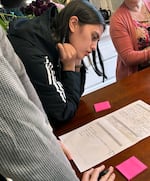
Lewis & Clark College social studies teaching candidate Madi Pastores looks at a lesson plan her classmate put together on how development impacts a neighborhood. Pastores was one of six graduate students on a field trip to a North Portland neighborhood last month.
Elizabeth Miller / OPB
“We can teach all the same concepts if we teach about cherries as if I give you the very boring, you know, plant biology lecture that I was gonna give you tomorrow,” Finkel said.
Field trips can be a memorable learning experience for students. But they can also be challenging to plan and find financial support for, especially as school districts struggle to balance their budgets.
The trip to Tubman is just one example of a place-based lesson. Finkel and Zall hope it’s something the future teachers can adapt to their own communities.
Finkel and Zall also hope the interactions between science and social studies on the Tubman trip will continue, and lead them to collaborate across subject areas once they enter the workforce.
“The more that novice teachers and young teachers come out of teacher education with these ideas, they can bring them into their teaching spaces and really connect with the veteran teachers who are already there and offer some of these ideas about collaboration,” Zall said.
Finkel said there should be more collaboration in schools — something that teachers have to prioritize but that also requires support from administrators.
“Without bringing everyone together, we don’t tell the whole story,” Finkel said.
“We also don’t get kids engaged, and we teach kids that science isn’t connected to anything other than the vocabulary we learn in biology, or that history isn’t connected to anything other than memorizing the Constitution.”